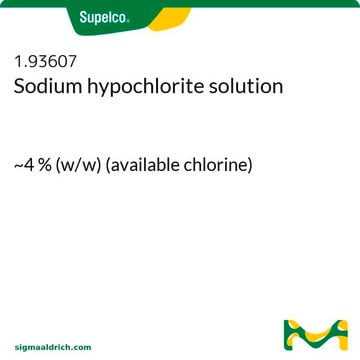239305
Sodium hypochlorite solution
reagent grade, available chlorine 4.00-4.99 %
About This Item
Productos recomendados
grado
reagent grade
Nivel de calidad
Agency
suitable for SM 4500 - NH3
presión de vapor
17.5 mmHg ( 20 °C)
Formulario
liquid
composición
available chlorine, 4.00-4.99%
idoneidad de la reacción
reagent type: oxidant
concentración
4.00-4.99% (chlorine by Na2S2O3, titration)
densidad
1.097 g/mL at 25 °C
temp. de almacenamiento
2-8°C
cadena SMILES
[Na+].[O-]Cl
InChI
1S/ClO.Na/c1-2;/q-1;+1
Clave InChI
SUKJFIGYRHOWBL-UHFFFAOYSA-N
¿Está buscando productos similares? Visita Guía de comparación de productos
Categorías relacionadas
Descripción general
Aplicación
- Primary alcohols to aldehydes or carboxylic acids and secondary alcohols to ketones.
- Aryl aldehydes to the corresponding acids in the presence of a phase-transfer catalyst.
- Ethers to esters by careful pH control (pH range of 8–9.5),
It can also be used as a reagent in the:
- Epoxidation of enones and polycyclic arenes.
- Oxidative degradation reaction
- N-Chlorination of primary and secondary amines
- Enantioselective epoxidation of α, β-unsaturated ketones
- Asymmetric dihydroxylation of olefins in the presence of an osmium catalyst
- Chlorination of allylic carbons in the presence of CeCl3
Características y beneficios
- Readily available reagent
- Easily handled oxidizing agent
- No phase-transfer catalyst is necessary for the oxidation of substrates in the pH range 10–11
- Simplified waste disposal and lower toxicity
Cláusula de descargo de responsabilidad
Palabra de señalización
Danger
Frases de peligro
Consejos de prudencia
Clasificaciones de peligro
Aquatic Acute 1 - Aquatic Chronic 2 - Eye Dam. 1 - Skin Irrit. 2
Código de clase de almacenamiento
12 - Non Combustible Liquids
Clase de riesgo para el agua (WGK)
WGK 2
Punto de inflamabilidad (°F)
Not applicable
Punto de inflamabilidad (°C)
Not applicable
Elija entre una de las versiones más recientes:
Certificados de análisis (COA)
¿No ve la versión correcta?
Si necesita una versión concreta, puede buscar un certificado específico por el número de lote.
¿Ya tiene este producto?
Encuentre la documentación para los productos que ha comprado recientemente en la Biblioteca de documentos.
Los clientes también vieron
Contenido relacionado
This page is intended to make it easier to find the consumables you need based on the analytical method you’re using. Methods included on this page come from the EPA, Standard Methods and ASTM.
This page is intended to make it easier to find the consumables you need based on the analytical method you’re using. Methods included on this page come from the EPA, Standard Methods and ASTM.
This page is intended to make it easier to find the consumables you need based on the analytical method you’re using. Methods included on this page come from the EPA, Standard Methods and ASTM.
This page is intended to make it easier to find the consumables you need based on the analytical method you’re using. Methods included on this page come from the EPA, Standard Methods and ASTM.
Nuestro equipo de científicos tiene experiencia en todas las áreas de investigación: Ciencias de la vida, Ciencia de los materiales, Síntesis química, Cromatografía, Analítica y muchas otras.
Póngase en contacto con el Servicio técnico







